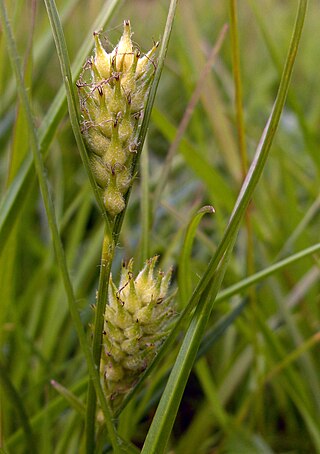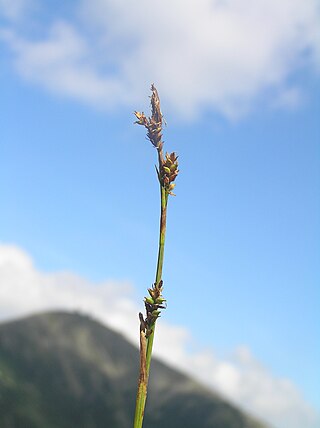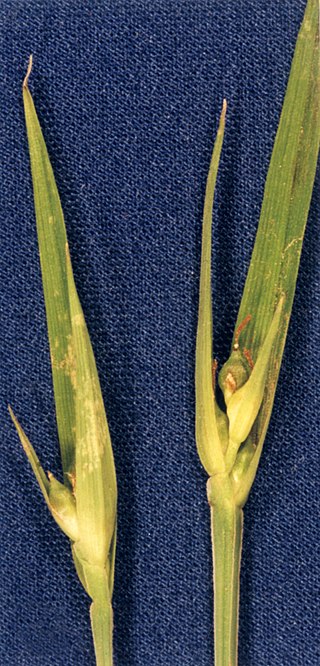
Carex comosa is a species of sedge known as longhair sedge and bristly sedge. It is native to North America, where it grows in western and eastern regions of Canada and the United States, and parts of Mexico. It grows in wet places, including meadows and many types of wetlands. Tolerates deeper water than most common species and is good for retention basins. This sedge produces clumps of triangular stems up to 100 or 120 centimeters tall from short rhizomes. The inflorescence is up to 35 centimeters long and has a long bract which is longer than the spikes. It is a cluster of several cylindrical spikes. The scales over the fruits taper into long, thin awns.

Carex lenticularis is a species of sedge known by the common names lakeshore sedge and goosegrass sedge. It is native to much of northern North America, including most all of Canada and the western United States, where it grows in wet habitats.

Carex rossii, commonly known as Ross's sedge, is a hardy species of sedge that is often a pioneer species in areas with little or no established vegetation, or in places where disturbance has occurred. Ross's sedge grows in a variety of habitats throughout much of western North America, from Alaska to Ontario, south to New Mexico and California. It flowers in May and June.

Carex pensylvanica is a species of flowering plant in the sedge family commonly called Pennsylvania sedge. Other common names include early sedge, common oak sedge, and yellow sedge.

Carex hirta, the hairy sedge or hammer sedge, is a species of sedge native across Europe. It has characteristic hairy leaves and inflorescences, and is the type species of the genus Carex.

Carex vaginata is a species of sedge known by the common name sheathed sedge.

Carex brunnescens, the brownish sedge or green bog sedge, is a species of plant in the sedge family (Cyperaceae). It has a circumboreal distribution, and is native to North America and Eurasia. In the United States it is primarily found in the Northeast and Midwest extending south into the Appalachian Mountains, with disjunct populations westward in the Rocky Mountains. It has a wide-ranging natural habitat, is in found in forests, bogs, fens, and rock outcrops.

Carex lacustris, known as lake sedge, is a tufted grass-like perennial of the sedge family (Cyperaceae), native to southern Canada and the northern United States. C. lacustris us an herbaceous surface-piercing plant that grows in water up to 50 cm (1.6 ft) deep, and grows 50–150 cm (1.6–4.9 ft) tall. It grows well in marshes and swampy woods of the boreal forest, along river and lake shores, in ditches, marshes, swamps, and other wetland habitat. It grows on muck, sedge peat, wet sand or silt, in filtered or full sunlight.

Carex adusta, commonly known as the lesser brown sedge or the browned sedge, is a species of sedge (Carex) in the section Ovales. First described scientifically in 1839 by Francis Boott, it is found in Canada and the northeastern United States, where it grows in dry, acidic, sandy soils. Adusta is Latin for "burnt," probably referring to the color.
Carex assiniboinensis, commonly known as the assiniboia sedge, is a species of sedge (Carex) in the section Hymenochlaenae. First described scientifically in 1884 by American botanist William Boott, it is found in Canada and the United States, where it grows in floodplain forests, old river channels, riparian woodlands, and shrub thickets.

Carex backii, commonly known as Back's sedge, is a species of sedge (Carex) in the section Phyllostachyae. First described scientifically in 1839 by American botanist Francis Boott, it is found in Canada and the United States, where it grows in shaded woods, shaded slopes, and shrub thickets.

Carex arctata, known as drooping woodland sedge, is a species of sedge native to eastern North America. It is sometimes called black sedge, compressed sedge, or drooping wood sedge. It occurs from Manitoba to the Maritimes in Canada, south to northwestern North Carolina, and west to Minnesota. Carex arctata grows in bogs, hardwood forests, and spruce forests.

Carex eburnea, known as ivory sedge, ebony sedge, and bristleleaf or bristle-leaved sedge, is a small and slender sedge native to North America, from Alaska and Newfoundland south to central Mexico.

Carex rosea, the rosy sedge, is a flowering plant and part of the family Cyperaceae. Synonyms for Carex rosea include Carex concoluta, and Carex flaccidula. It is native to central and eastern North America and it exists in wet to dry soils. Carex rosea can be found in shores of streams and bottomlands, as well as ponds. It is known to have good adaptations to dry-shade locations. It is an evergreen plant which is easy to grow.

Carex fascicularis, commonly known as tassel sedge, is a species of sedge of the family Cyperaceae that is native to Australia, New Zealand and New Guinea.

Carex davisii, known as Davis' sedge or awned graceful sedge, is a species of Carex native to North America. It is listed as an endangered, threatened, or species of concern across much of edge of its range. It was named in the 1820s by Lewis David de Schweinitz and John Torrey in honor of Emerson Davis (1798–1866), a Massachusetts educator and "enthusiastic student of the genus" Carex.

Carex baileyi is a sedge in section Vesicariae the genus Carex native to the Appalachian mountains in Eastern North America. It is commonly called Bailey's sedge. Carex baileyi was named in honor of Liberty Hyde Bailey by its discoverer, Nathaniel_Lord_Britton.

Carex muehlenbergii is a species of flowering plant, it is a type of sedge. It is a grass-like plant in the family Cyperaceae. Its common names include sand sedge, Muhlenberg's sedge.
Carex deweyanaDewey's sedge, short-scale sedge, is a species of sedge native to Canada and the United States.
Carex interrupta is a tussock-forming species of perennial sedge in the family Cyperaceae. It is native to south eastern parts of Canada and north eastern parts of the United States.

















